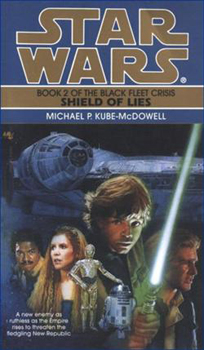The first thing you’ll notice about “Shield of Lies” (1996), the second book in Michael P. Kube-McDowell’s “Black Fleet Crisis” trilogy, is that it’s split into three parts: Lando, Luke and Leia. This is a little intimidating, because although the jumping-back-and-forth-between-plots approach is in some ways a cheap way to retain reader interest, it’s also … well … a GOOD way to retain reader interest. To be faced with three big chunks of story is daunting.
The three parts are in reverse order of quality, so while this approach builds anticipation for the major military conflict at the end, it’s also a bit of a slog to get through Lando’s exploration of the vagabond alien ship. The plot still has a bit of an Arthur C. Clarke-meets-L. Neil Smith charm, but the payoff is delayed until the third book.
Similarly, the Luke plot is a slow-burning mystery as he travels in a small Verpine Adventurer with Akanah to track down Luke’s “mom,” Nashira. On this journey, McDowell shows us two planets on different parts of the governmental spectrum and finds faults with each. Teyr is a tourist planet with heavy-handed government. Among the annoyances for Luke and Akanah are that they can’t choose their place of landing (they are told where to land, and that rails connect all the major ports) and there are long lines at every tourist attraction and even to get to the planet’s surface and to get onto each train.
Atzerri is a Free Trade planet, but the annoyances are just as plentiful. Luke and Akanah choose their landing pad, but they feel ripped off, and they are charged a fee with practically every step they take, including upon entrance to the Traders Plaza. It seems to me that Atzerri is an example of corporatism rather than the free market, since one can assume smaller shops would not want a cost barrier between themselves and potential customers. It seems unlikely that an upstart company would voluntarily join the plaza if it was allowed to get its start on the other side of the spaceport, where it wouldn’t have to charge an entry fee. So I’m assuming there is some governmental force overseeing this set-up.
By showing annoyances of government regulation (Teyr) and organized corporatism (Atzerri), McDowell suggests that neither approach is ideal. I suspect he may have been aiming for Regulated State vs. Free Market and suggesting that some sort of middle ground would be better, but if that’s so, it should be noted that he doesn’t portray a true free market — which is hard to do, because there are no modern real-world examples to draw from. Indeed, it’s hard to think of a truly free-market city in “Star Wars.” Mos Eisley immediately comes to mind, but even there we see a significant Imperial presence. And not just for the military purpose of finding the droids in “A New Hope.” “Tales from the Mos Eisley Cantina” delves further into the Empire’s hold on the city.

Among the Atzerri watering holes that Luke explores is a place called Jabba’s Throne Room, which includes actors playing all the major characters from that classic sequence in “Return of the Jedi,” including Oola, Bib Fortuna and the Max Rebo Band. I’ve always been uneasy about the notion that the details of Luke’s adventures in the original trilogy would be known to John Q. Public in the “Star Wars” galaxy. Sure, everyone would know he’s a hero of the Rebellion, and his major battlefield accomplishments. But it seems kind of odd that the specifics of a gangster’s palace are so well chronicled by historians. Remember, this is a galaxy where Luke – despite fairly aggressive research and all the insider contacts he could ever want – is not able to discover his birth mom’s identity until he’s in his 40s. I suppose we can explain it as the difference between the secretive Empire (which probably destroyed as many records as it could before Coruscant fell to the Rebellion) and the more transparent New Republic.
Along those lines, the Leia section of “Shield of Lies” intriguingly delves into war politics in a way that mirrors our modern times, although McDowell comes up with an extremely black-and-white good vs. evil scenario. At the end of “Before the Storm,” the Nil Spaar-led Yevetha massacred all the non-Yevetha in the Koornacht Cluster. Now the Republic is split between those who believe the Yevetha should pay for their crimes (Commander-in-Chief Leia leads this charge) and those who believe the Yevetha should be left alone. Compelling cases are made on both sides.
In the real world, I take the position of opposing United States imperialism, and I believe armies should be all-volunteer with open-ended contracts just like any other job. However, I don’t have a problem with the fact that the U.S. stepped in and stopped Hitler’s advance in World War II. Basically, the closer the scenario is to being clear-cut, the more I’m likely to accept the necessity of war. Although this would be extremely unlikely in the real world (for example, there were many oppressed Germans who paid taxes toward Hitler’s empire building), McDowell shows us that the Yevetha are a demonstrably evil race.
Unlike with the Yuuzhan Vong invaders of the “New Jedi Order” series, there are no sympathetic Yevethans. The culture is so much built around the concepts of superiority and inferiority that Spaar’s underlings are required to bear their throat to him, and he can take any female he chooses to be his mate. Spaar acquires a loyal cadre of subordinates and he can always kill them if he sees them as a threat to his power. If there’s any underground civil rights or anti-war movement on N’zoth, we don’t hear a peep about it in these first two books.
Although there is only one major space battle in “Shield of Lies” (which I’d argue is to the book’s credit, as they can get tiresome to read), McDowell’s writings on military strategy — via wise New Republic General A’baht — is quite good. A’baht takes a position common among military men who have no taste for politics: If given a mission, he wants the soldiers, ships and weaponry required to get the job done as quickly and efficiently as possible. Some of the decisions he and Leia have to make are horrific to contemplate – including sacrificing men on a crucial reconnaissance mission – but they feel like scenarios that really would crop up in war.
The big overarching question heading into the final book is: How are the three plotlines (Lando, Luke and Leia) going to link up? So far, they are completely separate stories. How smoothly and cleverly McDowell brings them together will determine whether the trilogy hits its mark or not.
P.S.: It’s May 25, so a hearty Happy Star Wars Day to all the true “Star Wars” fans out there who know the significance of the day.

